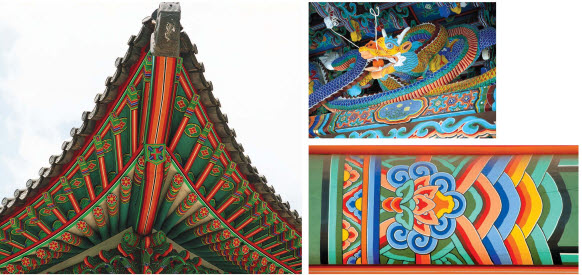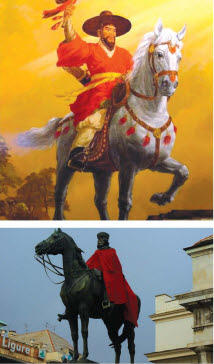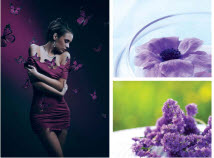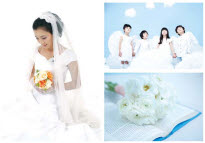‘One apple and two bananas’; ‘One red apple and two yellow bananas’. Which one sounds more delicious? Why do people feel wonder at blue roses and feel eager to see a pink whale? What will happen if the water color turns brown? We are surrounded by numerous colors and have gotten used to them. Now it’s time to look deeply into colors!
● Five Colors of Korea

Let’s first look at the colors of our tradition. Although most Koreans don’t know what the five colors imply accurately, they are familiar with those colors. There are so many relations between Korean tradition and the five colors that we have taken for granted.
Do you wonder how many other examples there are related to the five colors?
As you know, the five colors refer to Korea’s traditional colors: Yellow, Blue, White, Red, and Black, which are based on Yin-Yang and the Five Elements theory.
When it comes to Yin-Yang theory, it means all of the phenomena of the universe and humanity are decided by Yin and Yang’s expanding and extinction. Plus, the five elements theory means all things of the universe are created and go out of existence from Wood, Fire, Earth, Gold, and Water.
The five colors are considered pure and unadulterated, so Korean ancestors made brides wear red rouge on the cheeks and the forehead to drive evil spirits out. Also, they prayed for children’s good health and long life by letting them dress up in rainbow-colored Hanboks on holidays.
Now lets’ go back to the five colors. It will be helpful to understand if you read the article while referring to the pictures. As you can see in the picture, there is yellow at the center, black at the north, white at the west, blue at the east, and red at the south. White at the west is connected to gold and implies innocence, truth, life and purity, so we Koreans traditionally have preferred to wear white clothes. The meaning of the white clad-folk originated from this. Next, yellow implies earth and is considered honorably as the center of the universe, so yellow is used to make the clothes of the King. Blue implies trees and means the color of spring, defeating evil and wishing luck. As you can associate red with implying fire, it means creation, formation, passion and affection, and initiative. Finally, black is connected to water and is considered to take charge of wisdom.
We can see that these five colors have been used in various traditional assets such as dancheong in the palace and temple, patchwork wrapping-cloth, garnish on noodles, red clay houses and red amulet. These five colors are inherent and traditional colors that cannot be separated from Korea even now.
● History and Story of Color
Why don’t we take a look at some stories about colors? It will be the red color that comes to your mind when you think of history. That is because red has been recognized as a color related to history, policy, and revolution. We’ve researched out some people related to red in history.

A person in red also existed in Italy. He was Garibaldi of the ‘Red Shirts’. At that time, Italy was divided into many countries like Kingdom of Sardinia and Kingdom of Naples. Garibaldi, who aimed for republicanism, organized a group of people with red shirts and contributed to uniting Italy at the end of the 19th century. Even now, he is respected in his position as a hero by Italians.
How about looking at the history of the white color? Have you heard of the ‘White Rose’? That was a group of non-violent protesters organized by students in Munich University and their professors against the despotism of the Nazis. Hans Scholl and his sister Sophie Scholl were leaders of the group. They used the word ‘White Rose’ as the title of their leaflets, and this name came from a Spanish novel. Unfortunately, all members of the group were killed after they were discovered by a janitor while handing out the leaflets to passers-by in school.
Let’s take a look at the color purple. Ancient clerics and early Christians wore purple clothes. In addition, gods from Greek mythology wore the same color clothes and King Solomon’s carriage’s color was purple, too.
Why did they like purple? Purple symbolizes an emperor. This came from soldiers who came back after winning the war with purple capes. Therefore, purple is well known for clothes of kings and nobles. A reason why purple was used to make clothes for people in high places is because it was difficult to extract the dye. Purple dye is made from the clear body fluid of a snail, and the fact that people got just 1.4g of this dye from 200 snails is on record.
Another reason why purple symbolizes authority is that it is a neutral color. Purple is a neutral color between blue meaning heaven and red meaning blood of a person. That is, Purple implies an image of a man of dignity who delivers God’s words to the people.
Here is a lighter example. The 1990s in Korea were the days of the first generation idols.

● Color with Psychology
Color can not only be used to make the world colorful, but also be related to human psychology. People can feel comfortable or uneasy through color. Also, it can make consumers buy something or even get hungry. People often doubt if it can happen, but it’s definitely true in our lives.
-RED: Physical

-GREEN: Balancing
Green recalls in us a tree, meadow, forest and fresh breeze, so

-YELLOW: Emotional

-VOILET: Spiritual
First, this color is often described as purple. Second, the elderly tend to prefer violet more than the young. That’s why violet means

-BLACK
Black is an amazing color which can match any clothes, anything, and any time. This black indicates security, glamour, and efficiency, and it implies being confidential and veiled.

-WHITE

● Colors of CBNU
The main colors for CBNU are blue, sky-blue and wine.

Up until now, we’ve all looked at some colors and their meanings. Colors we missed in our lives turn out to be interesting and sometimes mysterious. A man in the movie ‘Siam Sunset’ took a far journey to find a new color that he has never seen while he was working at a paint company and finally fell in love with a girl he met at the end of the journey. Like him, can we get something else if we search for a new color around us?
GLOBE
globe@jbnu.ac.kr

